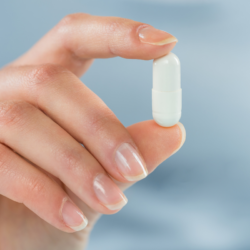Skin ageing is a natural process influenced by genetic, environmental and biological factors. With age, the skin loses elasticity and radiance due to a reduction in certain essential molecules, including Nicotinamide Adenine Dinucleotide (NAD ).
This coenzyme, essential to the cell repair and energy production processes, plays a key role in the fight against skin ageing. But how does it affect our skin and how can we restore its levels to preserve our youthful appearance? Let’s discover the benefits of NAD as an anti-wrinkle agent for firmer, more radiant skin.
Ageing, a natural process
The skin is an organ in constant renewal. Just like bones, skin cells die and renew themselves every day. In their normal function, skin cells renew themselves every 28 days, for a maximum of 50 cycles.
But as the skin ages, skin cell renewal slows down and can take more than 30 days. The oldest cells can then accumulate, giving the impression of a blurred complexion. But it can also lead to thickened skin, reflecting the dryness of the skin that is often the first complaint of people as they age.
If skin dryness and, above all, dehydration are not corrected, wrinkles will leave their mark more easily on the skin, especially as the latter also tends to become thinner. At the same time, changes occur in the dermis, responsible for its loss of tone and sagging, which is also underpinned by the melting of fatty and muscular tissue that no longer plays its supporting role. The volumes and appearance of the face gradually change, while wrinkles deepen.
What is NAD and why is it crucial for the skin?
Nicotinamide Adenine Dinucleotide (NAD ) is a coenzyme present in all living cells and essential to their proper functioning. It is involved in a number of essential biochemical processes, including :
- Cellular energy production via oxidative phosphorylation.
- DNA repair and protection against oxidative damage.
- Activation of sirtuins, enzymes involved in cell longevity.
As we age, NAD levels decline, leading to a reduction in the skin’s ability to regenerate itself, a key factor in skin ageing and the appearance of wrinkles, which is why it is known as an anti-wrinkle agent. This substance also serves to combat external aggressors such as UV rays and pollution.
In reality, this molecule is a dinucleotide, in that it is made up of a first nucleotide, whose nucleic base is adenine, joined to a second nucleotide, whose base is nicotinamide. It plays a crucial role in metabolic processes such as the production of energy in the form of ATP and the regulation of enzymes responsible for cell repair in the broadest sense.
The effects of NAD on skin ageing: an effective anti-wrinkle molecule?
The reduction in NAD is one of the major factors in the appearance of the signs of ageing:
- Wrinkles and fine lines due to reduced collagen production.
- Loss of skin firmness and elasticity.
- Dehydration and dryness caused by a weakening of the skin barrier.
By restoring levels, it is possible to reverse some of these effects and stimulate natural cellular repair mechanisms. These include the active elimination of damaged cells by apoptosis. But also the regeneration of cells by hyperplasia (increase in number) or hypertrophy (increase in size).
How does NAD stimulate cell regeneration?
NAD acts principally by activating two families of essential enzymes:
- Sirtuins (SIRTs), which regulate inflammation and extend the life of skin cells.
- PARPs, involved in repairing DNA damaged by UV rays and free radicals.
In addition, NAD supports mitochondrial function, guaranteeing a sufficient supply of energy for cell regeneration and the synthesis of collagen and elastin. The physiological reduction in mitochondrial activity with age leads to an accumulation of damage and accelerated ageing. NAD, thanks to its intervention, helps to maintain firmer, revitalised skin.
How can NAD levels be restored for radiant skin?
There are several strategies for restoring NAD levels and enjoying its anti-ageing benefits:
- Food supplements: NAD precursors such as Nicotinamide Riboside (NR) and Nicotinamide Mononucleotide (NMN) have been shown to be effective in maintaining NAD levels and improving skin health.
- Topical creams: Some cosmetic formulations enriched with NAD or its derivatives can be applied directly to the skin, stimulating local cell regeneration.
- Advanced therapies: Injections or infusions of NAD are proposed in anti-ageing medicine for targeted action on cellular ageing.
What are the concrete benefits of NAD for the skin?
- Reduction in fine lines and wrinkles by promoting collagen production.
- Repair of UV damage thanks to improved activity of DNA repair enzymes, which are essential for reducing the effects of photoageing caused by exposure to the sun
- Improved hydration and radiance of the complexion by reinforcing the skin’s barrier function.
- Reduced skin inflammation, beneficial for sensitive skin or skin prone to redness.
Conclusion: Why include NAD in your anti-ageing routine?
NAD is a key player in cell renewal and the prevention of skin ageing. As its decline is inevitable with age, it is essential to maintain a good level of NAD to preserve firm, smooth, radiant skin.
Whether through targeted supplementation or topical application, incorporating NAD into your anti-ageing routine could be the natural and effective solution to slowing the effects of time on your skin.
Sources
- The Role of NAD in Regenerative Medicine, Published online 2021
- Sun C, Wang K, Stock AJ, et al. Re-equilibration of imbalanced NAD metabolism ameliorates the impact of telomere dysfunction. EMBO J. 2020
- Laughlin T, Tan Y, Jarrold B, et al.. Autophagy activators stimulate the removal of advanced glycation end products in human keratinocytes. J Eur Acad Dermatol Venereol. 2020
- Exogenous Nucleotides Improve the Skin Aging of SAMP8 Mice by Modulating Autophagy through MAPKs and AMPK Pathways, Nutrients 2024
- https://actu.epfl.ch/news/le-nad-contre-la-deterioration-musculaire-liee-a-l/
- https://dermato-info.fr/fr/c-est-quoi-la-peau/le-vieillissement-de-la-peau





